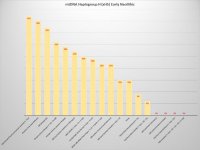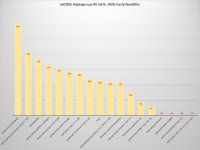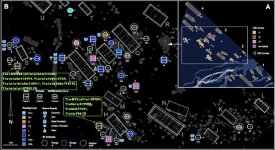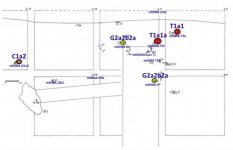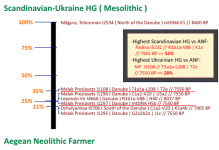The M70 mutation is particularly interesting because it only represents roughly 1% of chromosomes world-wide. It is, although, most common in east Africa and the Middle east. Thomas Jefferson's T-PF7444 is particularly interesting because it has a one-step match with an egyptian T haplotype. This is consistent with Jefferson's patrilineage belonging to an ancient and rare indigenous european type. M70 was identified in the Welsh Jefferson's DNA and in British (2/421 0.5%), Western French ( 3/561 0.5%) and Iberian Peninsula samples ( 13/987 1.3%). The haplogroup is rare world-wide, in 14,685 chromosomes in the literature, only 150 examples (1.02%) were found. Apart from 12 cases from non-indigenous populations of the USA, the samples are confined to Africa and western Eurasia. They reach their highest frequencies in the Middle East and Northern east Africa, exceeding 7% of the male population in Somalia, Oman, Egypt and Iraq. Samples were also found at a lower frequency in the central and western Mediterranean, including the Iberian Peninsula. Other high frequencies are reported in Druze, Palestinian, Ethiopian and Tanzanian samples (roughly 5%). Of 421 British males surveyed, only 0.5% were M70+. In a phylogenetic network, the "Thomas Jefferson" haplotype lies at the periphery of the network: It's nearest (one mutational step) genetic neighbour is an Egyptian, while spanish/portuguese haplotypes lie only 2 steps away. This seems compatible with the British examples, including the Jefferson haplotype, as being members of an ancient and diverse indigenous european lineage, rather than recent immigrants from the middle east. If there was no prior family history knowledge about the ancestry of the Jefferson paternal haplotype, it might be assigned to an Egyptian origin. This is consistent with T-PF7444, or a major part of this cluster as having Hispanic/ North-african roots. The presence of the Jefferson M70 haplotype in these apparently unrelated British men supports the general idea that the President's RECENT paternal ancestry is in Western Europe, rather than the middle east. In a separate study, 3 to 6 mutational step ancestors of the Jefferson haplotype were found in 7 Jews from different countries, 5 Egyptians, 2 Europeans, 1 Turk, 1 Syrian, 1 Jordanian and an African-American.
